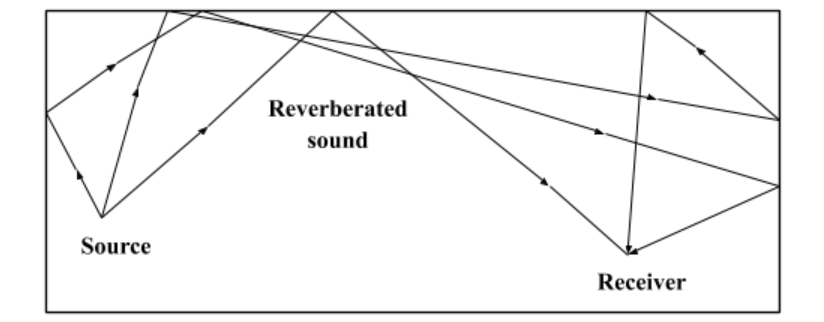
What is Reverberation?
Answer
560.4k+ views
Hint: Reverberation is the reflection of sound in an enclosed space, after the source of sound has stopped. This reflection is due to multiple reflection from surfaces such as plastic, furniture etc. The reflected sound is much louder than direct sound. It is not limited to indoors. You can experience it in forests as well as other outdoor environments. But, the condition for reverberation is that the reflection should be possible.
Complete step by step solution:

Reverberation is a phenomenon in which sound gets reflected as a result of multiple reflections from surfaces such as furniture, people etc. and then it starts decaying as it is absorbed by those surfaces. This occurs after the source stops producing sound. In this phenomenon, reflection can be either of sound or light waves. Reverberation is basically the occurrence of reflections that arrive in less than 50ms. Sound bouncing around in a large speaker is an example of Reverberation.
While designing auditoria, opera halls, theatres etc. this phenomenon is taken into consideration. Reverberation effects are used in studios to enhance the depth of sound. Reverberation in a room will cause people to raise their voices in an attempt to compensate for their inability to understand speech. This generally takes place at a party with loud speakers, in movie theatres etc.
The time taken by the reflected sound to become inaudible is known as Reverberation time. Reverberation time depends upon the dimensions of room and the absorptive properties of its surfaces and contents.
Note: Echo is similar to Reverberation. Echo is due to single reflection while reverberation is due to multiple reflections. But there are few differences. In case of Reverberation, the reflected waves are perceived by the brain as continuous sound. While in case of echo, if the delay between the first and second sound reaching our ear is 50ms or more than that then the brain perceives it as two separate events.
Complete step by step solution:

Reverberation is a phenomenon in which sound gets reflected as a result of multiple reflections from surfaces such as furniture, people etc. and then it starts decaying as it is absorbed by those surfaces. This occurs after the source stops producing sound. In this phenomenon, reflection can be either of sound or light waves. Reverberation is basically the occurrence of reflections that arrive in less than 50ms. Sound bouncing around in a large speaker is an example of Reverberation.
While designing auditoria, opera halls, theatres etc. this phenomenon is taken into consideration. Reverberation effects are used in studios to enhance the depth of sound. Reverberation in a room will cause people to raise their voices in an attempt to compensate for their inability to understand speech. This generally takes place at a party with loud speakers, in movie theatres etc.
The time taken by the reflected sound to become inaudible is known as Reverberation time. Reverberation time depends upon the dimensions of room and the absorptive properties of its surfaces and contents.
Note: Echo is similar to Reverberation. Echo is due to single reflection while reverberation is due to multiple reflections. But there are few differences. In case of Reverberation, the reflected waves are perceived by the brain as continuous sound. While in case of echo, if the delay between the first and second sound reaching our ear is 50ms or more than that then the brain perceives it as two separate events.
Recently Updated Pages
Why are manures considered better than fertilizers class 11 biology CBSE

Find the coordinates of the midpoint of the line segment class 11 maths CBSE

Distinguish between static friction limiting friction class 11 physics CBSE

The Chairman of the constituent Assembly was A Jawaharlal class 11 social science CBSE

The first National Commission on Labour NCL submitted class 11 social science CBSE

Number of all subshell of n + l 7 is A 4 B 5 C 6 D class 11 chemistry CBSE

Trending doubts
What is meant by exothermic and endothermic reactions class 11 chemistry CBSE

10 examples of friction in our daily life

One Metric ton is equal to kg A 10000 B 1000 C 100 class 11 physics CBSE

1 Quintal is equal to a 110 kg b 10 kg c 100kg d 1000 class 11 physics CBSE

Difference Between Prokaryotic Cells and Eukaryotic Cells

What are Quantum numbers Explain the quantum number class 11 chemistry CBSE




